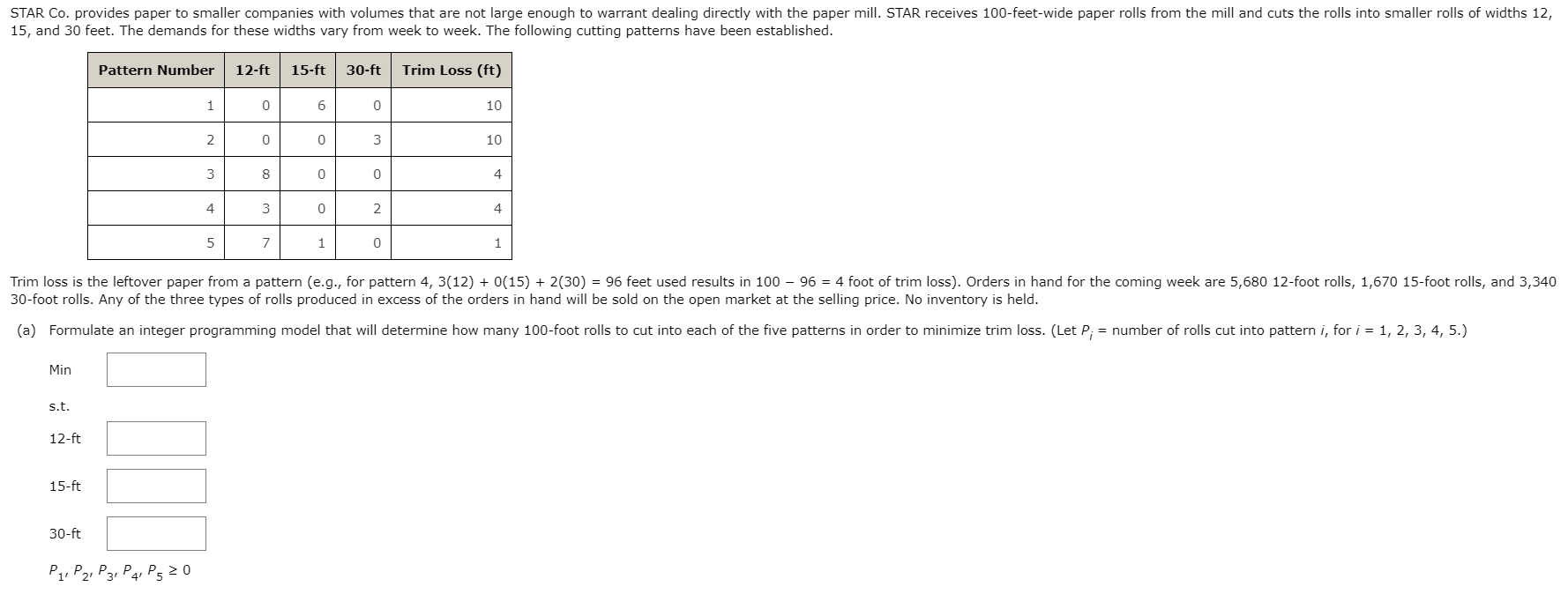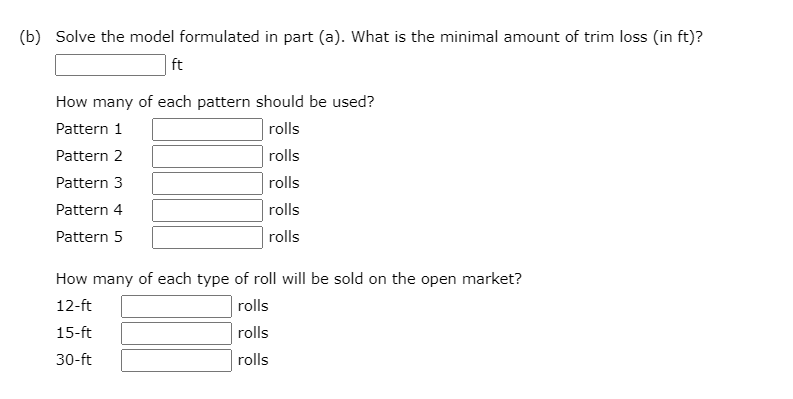
 undefined
undefined
STAR Co. provides paper to smaller companies with volumes that are not large enough to warrant dealing directly with the paper mill. STAR receives 100-feet-wide paper rolls from the mill and cuts the rolls into smaller rolls of widths 12, 15, and 30 feet. The demands for these widths vary from week to week. The following cutting patterns have been established. Pattern Number 12-ft 15-ft 30-ft Trim Loss (ft) 1 0 6 0 10 2 0 0 3 10 3 8 0 0 4. 4 3 0 2 4 5 7 1 0 1 Trim loss is the leftover paper from a pattern (e.g., for pattern 4, 3(12) + (15) + 2(30) = 96 feet used results in 100 96 = 4 foot of trim loss). Orders in hand for the coming week are 5,680 12-foot rolls, 1,670 15-foot rolls, and 3,340 30-foot rolls. Any of the three types of rolls produced in excess of the orders in hand will be sold on the open market at the selling price. No inventory is held. (a) Formulate an integer programming model that will determine how many 100-foot rolls to cut into each of the five patterns in order to minimize trim loss. (Let P; = number of rolls cut into pattern i, for i = 1, 2, 3, 4, 5.) Min s.t. 12-ft 15-ft 30-ft P1, P2, P3 20 (b) Solve the model formulated in part (a). What is the minimal amount of trim loss (in ft)? ft How many of each pattern should be used? Pattern 1 rolls Pattern 2 rolls Pattern 3 rolls Pattern 4 rolls Pattern 5 rolls How many of each type of roll will be sold on the open market? 12-ft rolls 15-ft rolls 30-ft rolls STAR Co. provides paper to smaller companies with volumes that are not large enough to warrant dealing directly with the paper mill. STAR receives 100-feet-wide paper rolls from the mill and cuts the rolls into smaller rolls of widths 12, 15, and 30 feet. The demands for these widths vary from week to week. The following cutting patterns have been established. Pattern Number 12-ft 15-ft 30-ft Trim Loss (ft) 1 0 6 0 10 2 0 0 3 10 3 8 0 0 4. 4 3 0 2 4 5 7 1 0 1 Trim loss is the leftover paper from a pattern (e.g., for pattern 4, 3(12) + (15) + 2(30) = 96 feet used results in 100 96 = 4 foot of trim loss). Orders in hand for the coming week are 5,680 12-foot rolls, 1,670 15-foot rolls, and 3,340 30-foot rolls. Any of the three types of rolls produced in excess of the orders in hand will be sold on the open market at the selling price. No inventory is held. (a) Formulate an integer programming model that will determine how many 100-foot rolls to cut into each of the five patterns in order to minimize trim loss. (Let P; = number of rolls cut into pattern i, for i = 1, 2, 3, 4, 5.) Min s.t. 12-ft 15-ft 30-ft P1, P2, P3 20 (b) Solve the model formulated in part (a). What is the minimal amount of trim loss (in ft)? ft How many of each pattern should be used? Pattern 1 rolls Pattern 2 rolls Pattern 3 rolls Pattern 4 rolls Pattern 5 rolls How many of each type of roll will be sold on the open market? 12-ft rolls 15-ft rolls 30-ft rolls

 undefined
undefined





